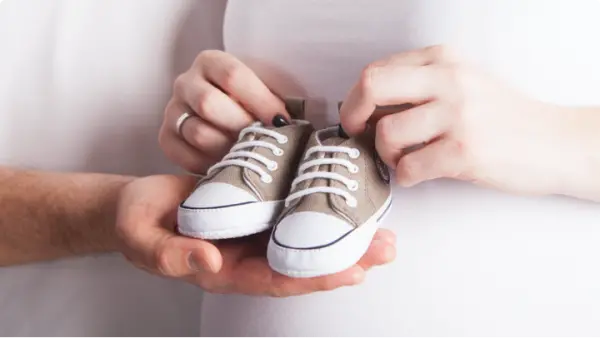How Does Age Affect Fertility?
Age is becoming a more important factor because most couples, in today’s times, wait to get pregnant until their 30s or 40s. With age, a woman’s chances of becoming pregnant decline significantly. The reasons for this include:
- A decrease in the overall number of eggs.
- Many eggs have an abnormality chromosomes.
- An increased risk of other health conditions.
Unfortunately, there may be no relevant female infertility symptoms other than not being able to get pregnant. Sometimes women with infertility may experience signs, including irregular or absent menstrual periods or those related to hormonal imbalance.
Who Is at Risk of Female Infertility?
Many conditions can trigger female infertility and put parenthood at risk. Some of these may be attributed to genetic conditions, lifestyle choices, etc. Specific factors can include:
- Age
- Hormone dysfunction that prevents ovulation
- Abnormal menstrual cycle
- Obesity
- Being underweight
- Endometriosis
- Structural problems with the fallopian tubes or cavity of uterus.
- Uterine fibroids
- Cysts
- Tumors
- Autoimmune disorders (lupus, rheumatoid arthritis, Hashimoto’s disease, overactive thyroid )
- Sexually transmitted infections (STIs)
- Polycystic Ovary Syndrome (PCOS)
- Primary Ovarian Insufficiency (POI)
- Smoking
- Substance use (heavy drinking)
- DES syndrome
- A past ectopic (tubal) pregnancy
Female Infertility Tests and Diagnosis
Your doctor will begin by asking some questions related to your sexual habits to understand female infertility causes.
Fertility for women depends on the healthy store of eggs in the ovaries. The reproductive tract must facilitate the movement of eggs into the fallopian tubes and mixing with sperm for fertilisation. The fertilised egg or embryo must be able to travel to the uterus and attach itself to the lining.
So, infertility tests and diagnostics aim to rule out the dysfunctionality of any of these processes.
These tests may include:
- Ovulation testing ~ It is a blood test that measures hormone levels to examine if you are ovulating.
- Ovarian reserve testing ~ The test helps determine the approximate amount of eggs present in the ovaries at a given age. This directly correlates with chance of conceiving either naturally or by assisted conception.
- Hysterosalpingography ~The diagnostic test evaluates the condition of your uterus and fallopian tubes to map out any blockages or structural problems. After injecting a contrast, an X-ray is done to determine if the uterus is of normal size and shape and see if the fluid comes out of your fallopian tubes at the other end.
- Imaging tests ~ A pelvic ultrasound can be used to check for uterine or ovarian disease. Sometimes, a procedure called a sonohysterography is done to examine the inside of the uterus, which is not visible on a regular ultrasound. This procedure uses sound waves to “see” inside the uterus.
- Other hormone tests ~ Other tests include checking for ovulatory hormones and pituitary hormones that regulate reproductive processes.
Treatment Options for Female Infertility
Depending upon the health condition and needs, some women might only need one or two therapies to improve fertility. Others may need a combination of different types of treatments for a successful pregnancy.
Stimulating Ovulation with Fertility Drugs
Women who experience fertility issues due to ovulation may be treated with the help of fertility drugs. These medications work like or influence natural hormones and are pretty efficient in inducing or regulating ovulation. There are so many fertility drugs that may be helpful; talk to your fertility specialist and discuss the benefits and risks of each type.
Surgical Interventions To Restore Fertility
If there is a blockage in the fallopian tube, surgery can be used to clear the obstructions. This allows the eggs to sweep through more easily and promote fertilization.
Uterine problems, such as a uterine septum, endometrial polyps, intrauterine scar tissue, and some fibroids, can be well managed with hysteroscopic surgery.
For some larger fibroids, endometriosis, pelvic adhesions, laparoscopic surgery has proven to be successful. During the surgery, a surgeon will make a small incision in the abdomen. A laparoscope, which is a thin, metal microscope, is inserted through a cut near the belly button to avoid a visible scar, followed by opening blocked tubes, remove cysts (fluid-filled tissues that can form in the ovaries) and restore fertility.
Assisted Conception
The following treatments for female infertility are available for assisted conception.
- Intrauterine insemination (IUI): The method involves placing sperm through the cervix into the uterus during ovulation. A physician will use a very thin catheter to insert healthy sperm directly into a woman’s uterus. This method can be helpful in cases where the male has a low sperm count.
- In-vitro fertilisation (IVF): With this procedure, sperm and egg are fertilised outside the human body. Sperm is collected and mixed with mature eggs in a petri dish. After successful fertilisation, the embryo is placed in the uterus for the pregnancy with the help of an embryo transfer catheter. Extra embryos can be frozen for future use if both partners agree.
- Intracytoplasmic sperm injection (ICSI): It is a specialized form of IVF in which a single sperm is injected into a mature egg to achieve high odds of fertilization. It is a highly beneficial procedure for men with low sperm count or concentrations.
- Egg donation: Sometimes, eggs from donors can be used for couples where female partners have low number and poor quality of eggs. but have a healthy uterus otherwise. It involves retrieving eggs from the donor’s ovary after taking fertility drugs, fertilizing them with husband’s sperm, and transferring them into the woman’s uterus who wishes to get pregnant.
- Assisted hatching: The embryologist marks a small hole in the embryo’s outer membrane. . The idea is that ensuring assisted hatching might help the embryo expand better and attach to the uterine wall so that pregnancy can be achieved. Ideally, the procedure is helpful for women who have failed to achieve pregnancy in previous IVF cycles. But not effective if there has been a poor embryo growth rate. In many women, the membrane becomes harder as they age, making it challenging for the embryo to hatch out itself.
- Surrogacy or Gestational carrier: A gestational carrier is another treatment option for female infertility. This option is ideal in cases where a woman’s uterus is functionally impaired or for whom pregnancy may pose a severe health issue. With this method, the couple’s embryo is placed into the uterus of a surrogate or gestational carrier. The surrogate carries the baby for nine months in her womb and gives birth on behalf of the couple.
Can Female Infertility Be Prevented?
In most cases, female infertility can’t be prevented. However, there are certain steps that a woman can take to improve the chances of conceiving. For example, lifestyle habits like alcohol use and smoking if eliminated, can improve fertility. Similarly, maintaining a healthy weight and regular physical exercise will also help. Consult your fertility specialist and discuss other risk factors that may affect female fertility.
Coping With Infertility
Managing infertility can be stressful because of so many unknown factors. The journey can be emotionally overwhelming for the couple. In addition, stress can also increase the risk of infertility. That’s why it’s essential to manage it.
Here are some ways to cope with infertility
- Be prepared. Fertility treatment can be stressful. It’s a large commitment and involves repeated tests, procedures, and treatments, which can be stressful. Ask your doctor about explaining each step well and prepare yourself for what’s to come.
- Communicate with your partner. Fertility treatments can be expensive and time-consuming. It’s important to discuss what treatments you are willing to undergo. Talk about the impact that it will have on your life.
- Consider alternatives. It’s easy to get discouraged when one treatment doesn’t work. But there are a variety of options, including donor eggs, gestational carriers, and other alternatives. Ask your doctor what the best treatments are for you.
- Support and counseling: Seek assistance from counselors for help before and after treatment to ease the emotional process.
Words From ART Fertility
When it comes to infertility, treatment options have improved in the last couple of decades. If you and your partner have been trying to conceive for 12 months or more without success, you can get in touch with our infertility specialists available in India, UAE & Oman.
Once the cause is determined, your fertility specialist can help create a treatment plan to move forward. Thanks to the many options available, it is possible to have a successful pregnancy in most cases.






